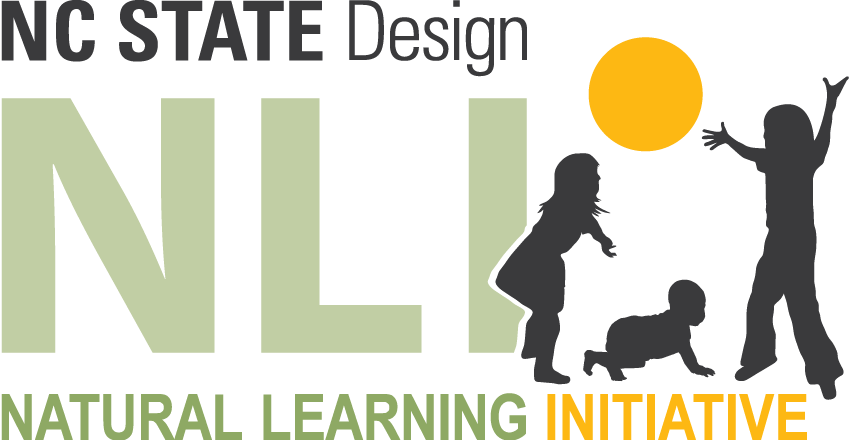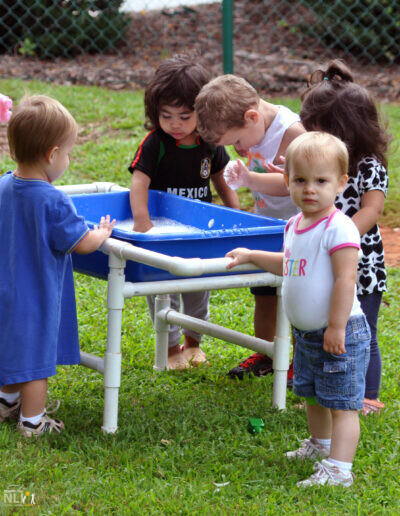40. Water Play
Water offers endless, multi-sensory, interactive play and learning opportunities like floating leaves and other “floatables,” manipulating flow with movable stones, pouring from containers, splashing, “painting” with water, and more. The sound of running water with sunlight glinting off ever-moving water surfaces increases sensory impact. Misting creates mini-rainbows that playfully intrigue and connect children to the larger world.
TYPES OF WATER PLAY & LEARNING SETTINGS
Water play and learning settings can be categorized as either hands-in or full-body, each with particular characteristics and requirements. In either case, water must be potable.
Hands-in settings connect children easily to water and endless, flexible possibilities provided by portable items and loose parts including tubs, trays, and small containers (purpose-made and re-purposed). Water is commonly delivered via a fillable reservoir or various types of hand pumps.
Elevated, interconnected water tables offer a flexible, wheel-chair friendly, hands-in option that extends the water play season and is usable by diverse groups of children. Manufactured water tables can be purchased and are easily moved and stored when not in use. More elaborate, multi-tiered water tables can be designed as permanent best practice installations.
In-ground, hard-surfaced streams (similar to dry stream beds), are another, more naturalistic hands-in option. Although the play value may be limited by season, they can be designed as drainage outlets, carrying water away from water tables or other components. Children can play and learn by manipulating water flows, creating dams with loose parts, and floating objects down the stream.
A multitude of natural and manufactured loose parts can add play and learning value to water settings. They include natural objects such as sticks, acorns, pinecones, and leaves that can be scavenged from the vicinity. Manufactured items such as balls, boats, and rubber ducks provide unique color, texture, and buoyancy. Utensils such as bowls, cups, ladles, pitchers, water bottles, and funnels can be used to scoop, pour, stir, and spill water for endless fun!
Full-body settings are ideal for cooling off during the hot summer months while stimulating vigorous, active play. They include water delivered as spray or mist. For low-cost solutions, place a sprinkler in the center of a multi-purpose lawn or suspend a hose with a soft spray head from an arbor or pergola. Either will afford active, gross motor chase play as well as focused attention on the behavior of water. Misting is an alternative option using affordable components easily installed in an arbor, pergola, or other overhead structure. Full-body water play can include all kinds of colorful squirt toys suitable for preschoolers. A more expensive option includes permanent, valve-operated, ground-level spray heads mounted in a concrete slab with a poured-in-place safety surface.
On designated “water play days” make sure children come prepared with a change of clothes and towel for drying off. Identify spots (fences, temporary clothes lines) where wet/damp clothes and towels can dry.
DESIGN CONSIDERATIONS
Water supply. Use potable water that drains into either a sewer system, rain garden, or flows into a dry stream bed. Harvested rainwater or standing outdoor water should not be used.
Drainage. Water settings should drain at the end of each day to avoid standing water.
Setting size. A sand play setting can range between 40–300 square feet, depending on the available space and age of children served.
Regulations. Consult local regulations that may apply to childcare center water installations.
Surfacing. Surfaces around water play settings should be non-skid and well-drained.
Shade. Ensure that children are protected from harmful UV light by providing adequate shade for water play and learning settings, especially during the summer months. Temporary shade solutions such as shade sails and umbrellas can be used while permanent solutions, such as shade trees or pergolas, become available.
Water-related play and learning settings that may benefit from functional adjacency and/or shared water hook-ups can be found in the following InfoSheets: 12: Arbors, Pergolas, & Trellises; 15: Sand Play Settings; 16: Multi-purpose Lawns; 34: Mud Kitchens; and 36: Dry Stream Beds.
Health and Safety
- Never use gray water or run-off for hands-in or full-body water play. This includes harvested rainwater, snowmelt, or standing water on site. Use potable running water from an outdoor faucet.
A single tray, manufactured, moveable water table is inexpensive and serves a range of play and learning purposes such as soap play.
Raised, multi-level, interconnected water table. Water is supplied by an adjustable valve and exits into a dry stream bed converted from an eroding ditch.
Ground-level channel flowing from spray space motivates preschooler toy truck play. Note water-loving vegetation.






